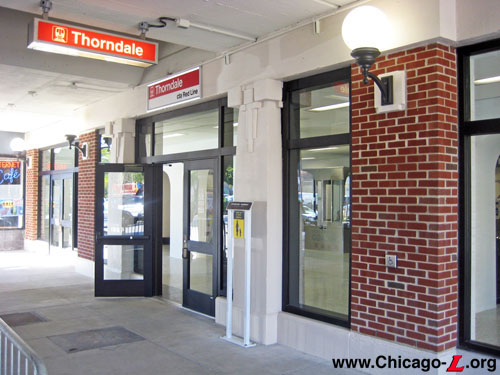
The front entrances of
Thorndale station, looking northwest on September 29, 2012, the first full day the station was open after renovation. The
pilasters framing the doors and the ornamentation around the
light fixtures convey the station's Prairie School
influences. For a larger view, click here.
(Photo by Graham
Garfield)
|
Thorndale
(5900N/1200W)
Thorndale Avenue and
Broadway, Edgewater
Service
Notes:

|
Red Line:
Howard |

|
Owl
Service |
Quick Facts:
Address: 1118 W. Thorndale
Avenue
Established: February 14, 1915
Original Line: Northwestern Elevated Railroad
Previous Names: none
|
Skip-Stop Type:
|

|
Station
|
Rebuilt: 1921, 2012
Status: In Use
History:
"L" service first entered north Chicago and Evanston by way of an
agreement to use the tracks of the Chicago, Milwaukee and St. Paul
Railway's tracks, replacing the steam service that
the St. Paul had previously provided. The Chicago City Council
authorized the electrification of the tracks of the Chicago,
Milwaukee and St. Paul Railroad's tracks from Graceland Avenue
(Irving Park Road) to the city limits on July 1, 1907. Unlike Evanston (as per the 1907 franchise agreement from the city),
the Chicago City Council did not require that the grade-level tracks
be elevated, but they did prohibit the use of a third rail for
safety's sake, necessitating the use of overhead trolley wire. "L" service north of Wilson to Central Avenue in Evanston began on May 16, 1908.
Track Elevation and a New Station
In the mid-1910s, the Northwestern Elevated began to elevate the
tracks north from Wilson to Howard, but
work was slow due to the city's refusal to close intersecting streets
and the narrow right-of-way. The elevation work involved complex staging and the temporary relocation of tracks to maintain service while building the new elevated embankment in the same right-of-way.
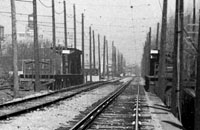
A view looking north during the track elevation project circa 1915 shows the first, temporary Thorndale station platforms. For a larger
view, click here. (Photo by A.F. Scholz Photography, from M.D. McCarter Collection) |
Unlike the other locations along the new "L" extension where there are currently stations, the St. Paul had not had a station at Thorndale Avenue. The station was added as a result of community advocacy and pressure. Following the extension of "L" service through the Edgewater community, development accelerated along both Winthrop and Kenmore to the east of the tracks, and west of Broadway on the west side of the tracks, with scores of apartment buildings increasing population density. New residents of this central area of Edgewater wanted a shorter walk to the “L”, so they petitioned for a new station to be added between the two existing stations at North Edgewater (Granville) and Edgewater (Bryn Mawr). Petitioning began as early as August 1913 -- an August 30 article in the Chicago Tribune notes that the Thorndale Improvement Association had enlisted women voters in a petition drive to secure a station at Thorndale, and that in short order they had secured more than 1,200 signatures. The Illinois Public Utilities Commission issued an order on November 12, 1914 to the Northwestern Elevated Railroad to add a station stop at Thorndale.1
Not everyone was onboard with adding a station at Thorndale, however -- not only did the Northwestern Elevated not voluntarily agree, but some local residents and institutions resisted as well. An item in the December 23, 1914 issue of the Chicago Tribune indicated that A.T.H. Brower, of 1010 W. Bryn Mawr and past president of the Edgewater Improvement Association along with Edgewater Architect J.E.O. Pridmore, president of the North Edgewater Improvement Association, Mrs. Ella Flagg Young, Superintendent of the Chicago Board of Education, and Harriet A. Eckhart, principal of the George B. Swift school, asked the Illinois Public Utilities Commission to modify its order. The Chicago Board of Education felt that if a station were added at Thorndale, it would make the street a "heavily traveled thoroughfare and would interfere with the work of the Swift School." Supporters of the Thorndale station threatened to appeal to the Superior Court of Sangamon County. It is not clear how the controversy was resolved, but supporters of a station at Thorndale won -- the station was opened less than two months later.2
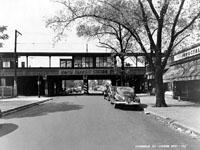
Thorndale station is seen looking west on Thorndale Avenue circa the 1940s. Although the details have changed -- the partitions, furniture, and stairway enclosures on the platform; the identification sign on the viaduct; the cars and street lights on the street -- the structure is the same today. For a larger
view, click here. (Photo from the CTA Collection) |
Thorndale opened on February 14, 1915, amid the project to elevate the North Side "L" tracks; Edgewater Beach [Berwyn] station was also added during the elevation project. This meant that the first Thorndale station was actually a temporary facility; based on the only photo of it known to exist, it was a simple, wooden structure. In early 1916, trains were moved onto a
temporary trestle, allowing demolition of the original tracks and stations, but construction of a permanent embankment had to
wait until the end of World War I due to a materials shortage. This seems to indicate that
the Thorndale station at this time was temporary, as the
embankment had not been completed.
As part of the track elevation, a new, permanent station was constructed. The entrance to the "L" station was located on the north
side of Thorndale Avenue. The station had a design typical of the
facilities built as part of the Wilson-Howard elevation project.
Designed by architect Charles P. Rawson and engineered by C.F Loweth,
the architectural design was a Prairie School-influenced vernacular
form, with the Prairie influence seen most acutely in the ornamental
cement pilasters on the front facade and in the details of the wooden
doors, windows, and ticket agents' booths. The exterior was brick and
cast concrete with a bedford stone base, wooden doors and large plate
glass windows and transoms. Ornamental globed light fixtures
decorated the pilaster capitals. The station house was centered
within the solid-fill embankment, with retail spaces flanking it on
both sides filling in the remaining width of the embankment.
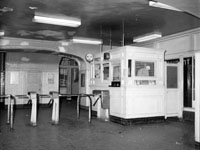
The interior of Thorndale station is largely unchanged in this view looking north in 1971 -- the original glazed brick and plaster walls, flooring, and wooden ticket agent's booth are still original -- but the details have begun to change with the times, such as the fluorescent fixtures and the agent's booth painted white, to present a brighter, more "modern" appearance. For a larger
view, click here. (CTA photo, from the Graham Garfield Collection) |
The interior was rendered in plaster, wood, glazed brick, and
brick with terrazzo floors. There were arches stretching across the
interior between the support columns. In the center of the interior,
passengers found a decorative wooden ticket agent's booth with
ornamental woodwork and a metal grille over the ticket agent's
window. The station also had public restrooms.
There were four tracks through Thorndale station, but the outer two tracks were for express trains and were not served by the station. A single island platform between the two center tracks served local trains. The platform
had wood decking and a canopy with metal columns down the center line
which split into gently-curving gull wing-shaped roof supports,
supporting a wooden canopy roof. The stairs were sheltered by wooden
enclosures with wooden bottoms and windows on top, divided into rows
of square panes, with swinging doors at the front of each enclosure. Like most of the stations north
of Lawrence, there was originally an
auxiliary exit, located on the south side of the street, descending down in
the middle of retail spaces built under the elevated. The auxiliary exit was closed and removed some time in the CTA era.
In December 1920, it was reported that the Thorndale station, along with Argyle, Edgewater Beach, Bryn Mawr, Granville, and Jarvis, would be completed by late Spring 1921.3 By
early 1922, the new four track mainline was completed, allowing full
express service to the city limits.
Due to low ridership and a budget crunch requiring economization, on February 9, 1992, Thorndale became a "part-time"
station, closed Sundays and holidays to save the
cost of the station ticket agent. The station's part-time status was repealed on July 9, 1995, after which the station would remained open seven days a week.
Recent Developments
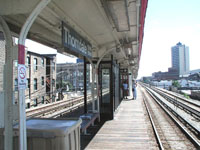
The island platform at
Thorndale, looking south on September 4, 2001, from just
north of the north stairs to the station house. The canopy
supports and roof structure all date from the construction
of the station in the early 1920s. The new gray Green Line
Graphic Standard sign was added in the late 1990s, though in a modified
fashion: the colored tabs on either side (which would be red
here) are omitted because the existing brackets could not
accommodate them. For a larger
view, click here. (Photo
by Graham Garfield) |
Thorndale was one of five Chicago Transit Authority sites
that were the first to provide access to vehicles belonging to
I-GO, a car-sharing program. At their August 11, 2004
meeting, the Chicago Transit Board approved the agreement
between the CTA , the
Center for Neighborhood Technology (CNT) and its affiliate
I-GO Car Sharing (I-GO) to promote the use of public
transportation by providing additional options for public
transit users. The agreement established a yearlong pilot
program where members can access I-GO vehicles at locations
adjacent to or near public transportation.
In 2006, the station name signs and column signs on the
platform were replaced, with Green Line
Graphic Standard signs replacing the KDR
Standard graphics, and new entrance signs installed as
part of a signage upgrade project on the Red Line. As part
of this effort, the station also received granite compass
roses inset into the sidewalk in front of the station
entrance to assist customers leaving the station to navigate
their way, and three-sided galvanized steel pylons in the
station house and on the platform to display maps and
station timetables.
In 2008, the canopy at Thorndale was refurbished. The roof was
removed and replaced with a new corrugated metal top. Wood paneling was installed under the metal cover, visible to passengers standing on the platform and looking up at the canopy, to maintain the historic aesthetic and design of the station canopy. The metal
canopy supports were stripped and repainted. New lighting was also
installed as part of the renovation. Around the same time, a white, perforated drop ceiling and new lighting were installed inside the station as well.
North Red Line Life-Extension Renovations
By the early 21st century, the stations, track, and elevated infrastructure on the north Red Line, between Wilson and Howard, were in severe need of rehabilitation, both to maintain a good state of repair as well as to modernize certain systems and amenities. The scale of the work and the funding necessary to undertake it were large enough that a broad study and planning effort were needed to properly scope the work and apply for sufficient funding. While this study was undertaken, and due to the presumed amount of time it would take to complete the study, secure funding, and complete design engineering, the CTA felt it was necessary to undertake modest-scale renovations in the meantime to extend the life of the existing infrastructure.
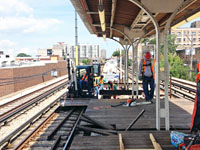
Construction crews work to remove the old wooden decking and joists on the Thorndale platform on August 18, 2012, the day after the station closed. The work will leave only the steel canopy structure and support stringers, which were refurbished, reinforced, and reused in the new station. After additional supports were installed, a new precast concrete deck was erected. For a larger view, click here. (CTA Photo) |
On February 8, 2012, the Chicago Transit Board approved the awarding of a design/build contract to Kiewit Infrastructure Co. to rehabilitate seven rail stations on the North Main Line section of the Red Line: Jarvis, Morse, Granville, Thorndale, Berwyn, Argyle and Lawrence. The work would provide a life-extension for the seven stations until a long-term capital improvement plan is determined for this portion of the Red Line as part of the Red-Purple Modernization Project (see below). "These interim improvements are important because we cannot postpone repairs which need our immediate attention. The CTA wants to be good stewards of the infrastructure we have now, as we continue to plan for the future and pursue additional funding," said CTA President Forrest Claypool. "This contract will allow us to quickly address some much needed capital maintenance work, while also improving the quality and experience for our riders and neighbors."
Kiewit Infrastructure Co. was awarded the contract to through a competitive bid process. Design work began in Spring 2012. Per the terms of the contract, construction was to conclude in early 2013 (though most work was actually completed by the end of 2012) and was not to exceed $57.4 million for services, labor and materials.
Construction plans included temporary station closures for no more than six weeks. Adjacent stations were not closed simultaneously. To minimize impact to customers, service reroutes were scheduled for overnight and weekends only.
Improvement work at each location included renovations to the station facilities, the viaduct, and the tracks. The station houses received new windows, doors and exterior lighting; exterior tuck pointing; improved station layouts; new turnstiles; new interior finishes, including new wall tiling, floors, walls and ceilings; new signage and interior lighting; and site improvements including sidewalk repairs and new bike racks. The platform deck structure and foundation was replaced, the platform fixtures, furnishings and canopy improved, and a new customer communication system installed. Concrete repairs to the viaducts and to the track-level walls were made at each station, and a new waterproofing and drainage system was installed. In addition, the viaducts received painting/coating and new, brighter lighting under the viaducts. New track, ties, and ballast was laid through the station area.4
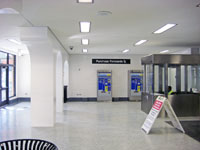
The interior of the renovated Thorndale station is seen looking west in the unpaid area on September 29, 2012. The rehabilitation gutted the interior and installed new terrazzo flooring, wall tiles, cement plaster walls and ceiling, lighting, and fixtures. The floor space was also expanded into adjacent former retail space -- the farecard vending machines are in what was formerly a separate storefront. For a larger view, click here. (Photo by Graham Garfield) |
The exterior masonry, including the brick walls and concrete trim, was cleaned and the brickwork re-tuckpointed. The wooden door and window frames were removed and a new dark brown aluminum storefront installed. New globed lights were installed on the piers.
Inside, the station house was gutted down to the structural shell. The retail spaces that originally flanked the station house on both sides were demolished and the common walls removed so that the station interior could be expanded into the former rental spaces. The concession stand added inside the station house opposite the agent's booth at an earlier date was removed as well. The enlarged station interior allowed for a more open space and improved passenger circulation. Farecard vending machines and the new Customer Assistant kiosk were installed in the former west retail space. The floor space formerly occupied by the east rental space was divided up, with the area toward the front of the station included in the newly expanded passenger space. A new wall was constructed roughly where the former wall between the station and rental space was to create a new enclosure, with the space in the middle of the station house for a concessionaire and the space in the rear for storage.
The interior walls were clad in new white modular glazed brick similar to the original material, though with some difference -- while the walls were originally clad only to a height just over 6 feet from the floor with plaster walls and ornamental trim above, nearly all of the renovated station interior's walls were clad in glazed brick up to the new suspended plaster ceiling. In addition, the free-standing columns, which originally were also tiled up to a height of about 6 feet and topped with a bullnose trim course, had their tiling removed and were refinished with a smooth plaster-cement skim coat. The middle portions of the center set of arches were removed, with the curved arches modified to taper up to the ceiling; the arches on the ends of the colonnades remain intact. The original ornamental trim on the plaster walls was not replicated in the renovated station, except on the rear angled wall under the south stairs to the platform which retained the original design of glazed brick extended up to a height of 6 feet, topped with a rounded bullnose trim, and cement plaster coating the walls above. In addition, the decorative tan art marble piers with ornamental Prairie School capitals that flank the front doors inside the station were retained and refurbished, and the original cast iron newel posts at the bottom of the stair railings were kept. A new light gray terrazzo floor with dark gray edges along the walls was installed on top of a sand cushion, and a new plaster ceiling installed with recessed lighting. A new Customer Assistant kiosk was also installed, typical of those installed by the CTA at new Brown Line stations and other recent projects like the renovations at North/Clybourn and Cermak-Chinatown, with stainless steel lower walls and roof and glass panels on all side for maximum visibility.
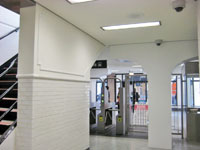
The only portion of the renovated interior that maintained the original style of white tiled walls up to a six-foot height, topped with a bullnose trim, and ornamental trim in the cement-plaster walls above, were the walls on the sides and back of the south stairs up to the platform. The west side wall is seen looking south toward the turnstiles and front of the station on September 29, 2012. For a larger view, click here. (Photo by Graham Garfield) |
The wooden platform deck was completely removed and new foundations and supports installed to supplement the original structure. A new precast concrete deck was installed, edged with blue tactile panels. The original 1921 platform canopy was retained, stripped, rehabilitated, and repainted. The canopy roof installed in 2008, including the wooden paneling on the passenger-facing underside to replicate the look of the original roofing, was retained. New fixtures including galvanized steel windbreaks and stairway enclosures, new benches, lighting, sandboxes, speakers, and signage were installed.
Installing elevators to make all the stations wheelchair-accessible is not part of the short-term project.5 Work was also planned for the roofs of adjacent station buildings, so that inside concession spaces can be leased and begin to generate revenue for the Authority.6
Thorndale temporarily closed for renovation at the end of the day August 17, 2012. The station reopened following renovation at 10pm, Friday, September 28, 2012.
Funding for the station rehabilitation project is from the Federal Transportation Administration (FTA) and is part of the $1 billion Red Line investment project. The $1 billion capital investment is a combination of state, local and federal funds, which will support other Red Line projects including track and station renewal along the Dan Ryan branch; the renovation of the Clark/Division and Wilson stations; and several other track, substation and station renewal projects along the North Side Main Line.
In addition to the renovation of the station, a "bike hub" was built across from the station on the south side of Thorndale Avenue underneath the elevated structure, in the space formerly occupied by retail spaces and the auxiliary exit from the platform (long since removed). The Thorndale Bike Hub, which was developed in cooperation between Alderman Harry Osterman, CTA, and the Chicago Department of Transportation (CDOT), includes well-designed racks for a capacity of 60 bikes and a new bike fix-it station for cyclists to utilize. CDOT will install a safe crosswalk under the viaduct and there will be new, bright lighting throughout the space. The bike hub is planned to be completed a few months after the station reopened.7 Although independent of the station renovation project, the installation of the bike facility was timed to coincide with the station improvement work.
The scope for the seven north Red Line stations also included new original artwork. At Thorndale, the installation was a glass mosaic, entitled "Thrive," designed by Jim Bachor. The mosaic is located on the columns that forms the arched colonnade that crosses the width of the interior unpaid area. The design depicts plants growing from the base of the columns and blooming into different icons that represent the neighborhood, such as a painter's palette, a sand pail and a school building. The artwork was fabricated in Munich, Germany, and installed inside the station in October 2014.8
Red-Purple Lines Modernization (RPM) Project
Due to the deteriorating condition of the infrastructure on the Red Line north of Belmont and on the Purple Line, the CTA initiated the Red-Purple Modernization Project (RPM) to bring the existing transit stations, track systems, and structures into a state of good repair. The project, which stretches along the existing Red and Purple lines from north of Belmont station to Linden terminal, would help bring the existing transit line into a state of good repair, reduce travel times, improve access to job markets and destinations, and provide improved access to people with disabilities.
The project began in 2009 with a vision study to assess the scope of needs and develop a set of alternatives for study. In 2010, in accordance with the National Environmental Policy Act (NEPA), CTA and Federal Transit Administration (FTA) initiated the environmental review process for the project and undertook work to develop an Environmental Impact Statement (EIS). The process included numerous public meetings and input opportunities, and study of various alternatives for achieving a good state of repair for the infrastructure in the project area.
A number of alternatives are under consideration for the RPM project, including the comprehensive reconstruction of track, stations, and structures along the line. The four options currently under consideration and study, not including an FTA-required "no action" baseline scenario, include:
- Basic Rehabilitation: provides a strategic mix of repairs, rehabilitation, and replacement of the existing infrastructure for a useful life of 20 years, plus the addition of a transfer station at Loyola; all station locations remain the same.
- Modernization with Station Consolidation: provides a brand new elevated structure between Lawrence and Howard, modern amenities at stations, increases speed of service, includes new transfer station at Loyola, and major reconstruction and renovation to extend the useful life to 60-80 years; several stations would be consolidated by closing one station and adding a second entrance at an adjacent station.
- Modernization without Station Consolidation: provides a brand new elevated structure between Lawrence and Howard, modern amenities at stations, modest increase in speed of service, includes new transfer station at Loyola, and major reconstruction and renovation to extend the useful life to 60-80 years; all station locations remain the same.
The Modernization with Station Consolidation option includes the consolidation of Thorndale station with the Granville and Bryn Mawr stations by closing the existing Thorndale station and adding entrances to Granville and Bryn Mawr -- at Glenlake Avenue for Granville station, approximately one block north of Thorndale station and one block south of Granville station.; and at Hollywood Avenue, approximately two blocks south of Thorndale station and one block north of Bryn Mawr station.
Other alternatives considered earlier in the study but subsequently eliminated due to public comment and further study included basic rehabilitation without adding a transfer station at Loyola, a modernization option with only three tracks between Lawrence and Howard, and a modernization option with a 2-track subway under Broadway.
The full-scale modernization envisioned on the Red-Purple Modernization Project could cost anywhere from $2.5 to $5 billion. On February 8, 2012, the CTA board retained Goldman Sachs & Co. to lead the search for public-private partnerships to help finance the reconstruction, which has no firm date. Goldman Sachs will work with Chicago-based Loop Capital Markets LLC and Estrada Hinojosa & Co., but will accept no fee for the first year as it determines the ability to raise private capital.
See CTA's Red & Purple Modernization page for more information about the scoping and planning process, and the various alternatives being considered.
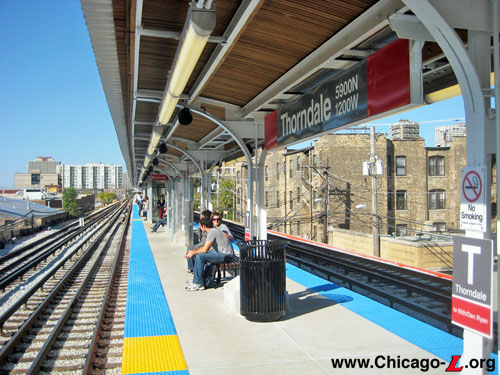
The Thorndale island platform, looking north on September 29, 2012, following renovation. The gullwing canopy is original to the 1921 station, but the recent rehabilitation replaced the wood platform deck with precast concrete, refurbished the canopy structure, and provided new platform signage and furniture. The wood beadboard under the canopy, installed in 2008 to provide a similar appearance to the canopy's original roofing, was retained in the renovation. For a larger view, click here.
(Photo by Graham
Garfield)
|

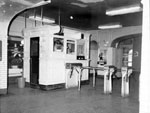
|
thorndale03.jpg (94k)
The interior of Thorndale station is seen here looking southeast from inside the paid area in 1971. The station's 1921-vintage ticket agent's booth is still in use -- note the fare registers mounted on the sides of the booth -- although it has now been painted white. The original terrazzo floors and glazed brick and plaster walls, including decorative molding above the wainscoting, are also still present, although the cement-plaster surfaces have begun to age, with many areas of visible patching. (CTA photo, from the Graham Garfield Collection)
|
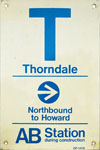 |
thorndale-P-8_KDRsignNB-tempAB.jpg (403k)
The design of this "KDR"-style
symbol sign from the northbound side of the island platform at Thorndale is both typical and unusual. Typical of this type and vintage of sign are the large first letter of the station name with the full name under it; a "KDR arrow" pointing in the direction of travel with the direction and destination in the middle; and the skip-stop station type at the bottom. The color is also standard -- in the KDR signage system, blue was for 'AB' or All-stop stations. What is unusual about it is that the colors are inverted -- typically, these signs are white type on a colored background. Also, Thorndale was an 'A' station, not an 'AB' station. This particular sign was temporary, dating from a track renewal project on the North Main Line in 1972-77. To keep both North-South Route and Evanston Express trains running during the project, work was staged over a long period of time, removing short sections of track from service at a time to minimize disruption. During some periods, some 'A' and 'B' stations were temporarily made 'AB' all-stop stations to help blunt the impact of some stages that involved bypassing a stop and requiring passengers to 'back-ride' to get to their intended station. Thorndale was an 'AB' station northbound from March 26 to August 27, 1977 while track 2 was out of service through Thorndale station and no southbound trains stopped there.
It is likely that the standard all-stop colors were used but the scheme inverted to make it stand out as being unusual and, above all, temporary. (Sign courtesy of Bill Wulfert) |
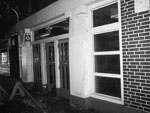 |
thorndale04.jpg (113k)
The exterior of the entrance to Thorndale station is seen looking west on May 6, 1986. The station's 1921facade is still intact in this view, including the original doors and windows. The only changes to the station are the painting of the cement piers and the removal of the original light fixtures. (CTA photo) |
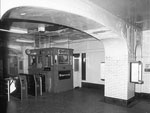 |
thorndale05.jpg (89k)
The interior of the Thorndale station is seen looking northeast in the unpaid area on May 6, 1986. The station still retains most of its original features here, including the terrazzo floors, glazed brick and cement-plaster walls, and decorative ticket agent's booth, now painted a dark color. However, the plaster has continued to deteriorate, and some of the patching has now resulted in the removal of sections of decorative moldings such as over part of the center arch. The station now sports modern, stainless steel GFI turnstiles. (CTA photo) |
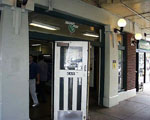 |
thorndale06.jpg (109k)
A close-up of the entrance to Thorndale station,
looking northeast in 1999. Note the 1950s-era CTA
logo over the door in the transom. The exterior masonry, doors, and
blue porcelain door signs are all original to the 1920s
station. (CTA Photo) |
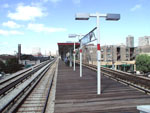 |
thorndale07.jpg (246k)
The island platform at Thorndale, looking north from
the south end on September 4, 2001. The lights were replaced
in the late 20th century and the metal latticed bracing
between the light poles was specially installed in the late
1990s when the new, gray Green Line
Graphic Standard name sign was installed. (Photo by Graham Garfield) |
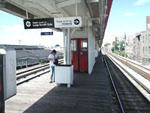 |
thorndale09.jpg (247k)
The Thorndale platform is seen looking north on September 4, 2001 toward the south stairs down to the station house. The two stairways between the station house and platform were originally enclosed in wood-framed vestibules with windows and swinging doors for weather protection. Although modified through a series of repairs over the decades, they still conveyed the general design of the originals until their removal in a platform renovation in 2008, when they were replaced with galvanized steel enclosures with perforated metal mesh over the windows and no doors. (Photo by Graham Garfield) |
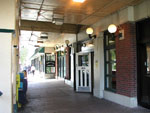 |
thorndale10.jpg (231k)
The front entrances of Thorndale station, looking west on September 4, 2001. The pilasters framing the doors and the ornamentation around the original light fixtures convey the station's Prairie School influences. (Photo by Graham Garfield) |
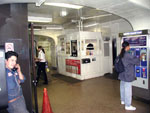 |
thorndale11.jpg (263k)
The interior of Thorndale station on September 4, 2001. The agent booth, with its intricate wooden moldings and decorations, is original, one of only a few left in the North Side embankment stations. (Photo by Graham Garfield) |
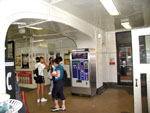 |
thorndale12.jpg (227k)
Several original elements are still in place inside the Thorndale station in this September 4, 2001 view looking east in the unpaid area, including the agent's booth, glazed brick wainscotting, decorative moldings in the plaster walls, and the terrazzo floors. However, time has begun to take its toll, with some deterioration evident in the flooring and plaster ornamentation. The east retail space flanking the station is occupied and accessible through the door ahead. (Photo by Graham Garfield) |
 |
thorndale13.jpg (213k)
After Thorndale closed for renovation at the end of the day on August 17, 2012, crews very quickly set about demolishing the station interior and platform fittings to allow renovation to begin. In this view inside the station on August 18, the turnstiles have been removed and demolition of the metal drop ceiling and glazed brick walls has begun. The original ticket agent's booth was removed and donated to the Illinois Railway Museum. (CTA photo) |
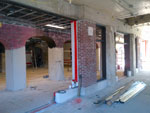 |
thorndale15.jpg (228k)
Renovation work at Thorndale is well underway in this September 15, 2012 view looking northeast from the street. The exterior masonry is in the process of being restored and the new aluminum storefront framing is being installed. Inside, the new glazed tile wall cladding has been installed and is covered by plastic sheeting to protect it while other work continues. A new cement-plaster skim coat has been applied to the arch columns, which would eventually be painted rather than having the original glazed brick replaced. (CTA photo) |
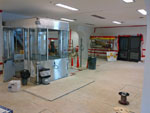 |
thorndale16.jpg (224k)
The interior of Thorndale station is nearing completion in this view inside looking northeast on September 22, 2012. The wall tiling, doors and windows, ceiling and recessed lights, and Customer Assistant booth are all in place. Boards protect the new terrazzo floor while finishing work continues. The station opened a week later. (CTA photo) |
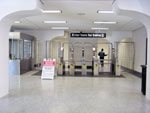 |
thorndale19.jpg (180k)
This September 29, 2012 view looks north into the Thorndale station house from the front entrance way. The space seen in this view encompasses the area of the original station house, but additional interior space is now offered (out of view) to the right and to the left, which the new Customer Assistant booth partially occupies. The middle sections of the center arches were removed in the renovation, as were their columns' tiling, with the surface of the arches and columns refinished in smooth cement-plaster. The rehabilitated interior also features a new plaster ceiling with recessed lights, new tiling on the side walls, new terrazzo floors, and new signage. (Photo by Graham Garfield) |
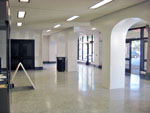 |
thorndale20.jpg (180k)
The renovated interior of the Thorndale station house is seen looking east in the unpaid area on September 29, 2012. This view looks into the expanded footprint of the station interior, which was formerly a separate retail space but whose common wall was removed so the station could expand into that area. The area on the right was added to the open floor space, while the area on the left was partitioned into a new concession space. The interior features new terrazzo floors, tile and plaster walls, plaster ceilings, security cameras, and new signage and other fixtures. (Photo by Graham Garfield) |
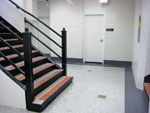 |
thorndale22.jpg (203k)
The south stairs up to the platform at Thorndale station are seen looking west on September 29, 2012; the north stairs are just in view on the far lower right. The original 1921 cast iron knell posts were retained in the rehabilitated station. This area was originally more "outdoor" in character as the station was originally built, with doors in the passageways flanking the stairs leading to the station house, enclosing the building, and with the walls in their area left bare concrete. In the rehabilitated station, most walls here are given more refined finishes, with terrazzo floors and tiled walls (though the rear walls, on the right, are still concrete) -- although the doors were removed, technically making this area open to the outdoors up at the platform level, this area is now more integrated into the station house interior. (Photo by Graham Garfield) |
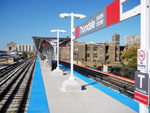 |
thorndale23.jpg (247k)
The renovated Thorndale station platform is seen looking north from the far south end on September 29, 2012. The refurbished platform includes new precast concrete decking with tactile edging tiles, new free-standing light standards and luminaires outside of the canopy, and new signage. The large angled concrete bases where the light poles and canopy columns meet the new platform result from work to shore up the platform structure and create new support footings. (Photo by Graham Garfield) |
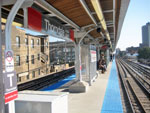 |
thorndale25.jpg (275k)
The renovated Thorndale station platform, seen looking south on September 29, 2012, retained the original 1921 gullwing canopy structure, rehabilitating and repainting the steel structure and retaining the new lights and canopy roofing installed in 2008. Due to the stations designation as being eligible for the National Register of Historic Places, the roof includes wood paneling on the underside, facing passengers, to replicate the look of the original station canopy (which was wood covered with tar and a built-up membrane). The renovated platform also includes new precast concrete decking, new sandboxes, new windbreaks, and new signage, including directional line diagrams like the one seen on the windbreak. (Photo by Graham Garfield) |
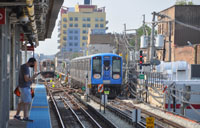 |
cta7004_20210728.jpg (353k)
Loop-bound Purple Line Express run 512, consisting of six prototype 7000-series cars trailed by 7004, is passing through Thorndale Interlocking on July 28, 2021, as viewed from Thorndale station. After passing through the interlocking, the train will be in the "2-track zone" between Thorndale and Montrose Interlocking, where two of the four tracks are removed and being reconstructed as part of the Red-Purple Modernization Project. (Photo by Lou Gerard) |

|

|
Notes:
1. Blommaert, LeRoy. "Edgewater's "L" stations", Edgewater Historical Society, Vol. XXVI No. 1, Spring 2015. Accessed 19 November 2017.
2. Ibid.
3. "3 NEW STATIONS ON NORTH SIDE "L" READY JAN. 1." Chicago Daily Tribune, 1920 Dec. 1, pg. 21.
4. Red North Station Interim Improvements webpage. Chicago Transit Authority, retrieved 25 March 2012.
5. Hilkevitch, Jon. "$57.4 million facelift program OK'd for 7 North Side stops on CTA's Red Line." Chicago Tribune. 8 February 2012.
6. Roberts, Bob. "Major Renovations Coming To Multiple Red Line Stations." CBS Chicago. 9 February 2012.
7. "New Thorndale Station and Bike Hub." News from the 48th Ward: Focus on Thorndale. 48thward.org. Accessed 11 October 2012.
8. Woodard, Benjamin. "Artist Jim Bachor's Mosaic 'Thrive' Installed at Thorndale 'L' Station", DNAinfo Chicago, October 9, 2014.






























